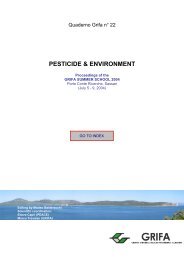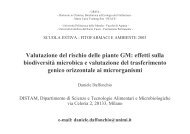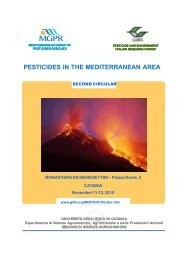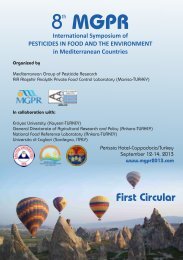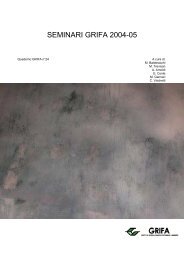International Congress BIOLOGICAL PRODUCTS - Gruppo di ...
International Congress BIOLOGICAL PRODUCTS - Gruppo di ...
International Congress BIOLOGICAL PRODUCTS - Gruppo di ...
You also want an ePaper? Increase the reach of your titles
YUMPU automatically turns print PDFs into web optimized ePapers that Google loves.
Soil samples were collected in the plots treated with : i) no input (CONTR); ii) fenamiphos (300 kg ha -1 )<br />
(F.MPHOS); iii) raw sewage (80 mc ha -1 ) (R.S.); iv) exhausted pomace solid cake compost ( 20 t ha -1 ) (EOPC); v) fresh<br />
pomace solid cake compost (20 t ha -1 ) (FOPC), after the treatments and harvesting to evaluate soil N-NO3, N-NH4<br />
exchangeable, NaHCO3 - P (Olsen method), exchangeable bases, CEC, heavy metals concentration , total organic<br />
carbon (TOC), total extracted (TEC) and humified carbon (humic and fulvic acids, C HA + C FA ) (Sequi et al., 1986;<br />
Italian Ministry of Agricultural Resources, 1994). The degree of humification, DH% = (C HA + C FA )/TEC*100, the<br />
humification rate, HR% = (C HA + C FA )/TOC*100, and the humification index, HI= NH / (C HA + C FA ), were also<br />
calculated.<br />
Data were statistically analysed by the analysis of variance and means compared by Duncan’s Multiple Range Test<br />
(P=0.05).<br />
RESULTS AND DISCUSSION<br />
In the field experiment all the composts significantly increased the tomato yield compared to the untreated control,<br />
but were statistically lower than chemical treatment (Table 1).<br />
All the treatments significantly reduced the root infestation index and, with the exception of the lowest rates of raw<br />
sewage and exhausted pomace compost, the soil nematode population (Table 1).<br />
Results from this experiment and their comparison with those from the previous field experiments evidenciated that<br />
incorporation of OMW into the soil could result in a suppression, but not in a complete era<strong>di</strong>cation of phytoparasitic<br />
nematode populations and, at low initial soil infestation, also in a crop yield increase. Therefore, the aim of soil<br />
amendments with these materials should be a progressive reduction of infestation level under the tolerance limit of the<br />
target nematode species (Sasanelli, 1994).<br />
Table 1 - Effects of <strong>di</strong>fferent olive mill wastes amendments on Meloidogyne incognita on tomato (cv. Ton<strong>di</strong>no <strong>di</strong><br />
Zagaria).<br />
Treatment<br />
Dose<br />
(t x<br />
ha -1 )<br />
66<br />
Tomato<br />
yield<br />
(t x ha -1 )<br />
Root gall index<br />
(0 – 5)<br />
Eggs and<br />
juveniles/cm 3<br />
soil<br />
Untreated control - 25.4 a 4,5 b 19.8 d<br />
Fenamiphos 0,3 40.5 e 2,7 a 10.6 abc<br />
Raw sewage 4 32.3 bc 2,4 a 15.1 cd<br />
8 29.0 b 2,5 a 5.2 a<br />
Exhausted olive pomace compost 10 36.8 d 2,1 a 13.7 bcd<br />
20 36.6 d 2,2 a 9.2 abc<br />
40 36.3 d 2,2 a 11.2 abc<br />
Fresh olive pomace compost 10 32.1 bc 2,8 a 5.3 a<br />
20 33.7 cd 2,2 a 7.1 ab<br />
40 35.8 cd 2,6 a 9.3 abc<br />
Data are means of four replications; data followed by the same letter on the same column are not significantly<br />
<strong>di</strong>fferent accor<strong>di</strong>ng to Duncan’s Multiple Range Test (P = 0.01).<br />
In the Figure 1 A can be observed a poor increasing trend of soil N-NO3 contents respectively for “R.S.”,<br />
“EOPC”, “FOPC” treatments and lowest N-NO3 content in “fenamiphos-treated” plots.<br />
Soil NaHCO3-P content was unaffected from experimental treatments, but soil exchangeable K showed higher<br />
value in "fenamiphos-treated" plots (Figure 1A). On the contrary, in “FOPC-treated” plots higher “exchangeable-Ca”<br />
content was recorded , while similar trends were observed in exchangeable Ca in “fenamiphos-”, “R.S.-”, “EOPC-<br />
treated” plots. No <strong>di</strong>fferences were observed on exchangeable Na and Mg among treated plots compared with the<br />
“control” (Figure 1 B ).<br />
Among the heavy metals of the soil (Figure 1 C ), only Zn content was higher in “EOPC-“ and “FOPC-treated”<br />
plots probably because during the composting processes of solid residual cake of olive milling ( fresh or exhausted ) a<br />
Zn concentration could be verified.<br />
Soil organic C (Figure 1 D) contents (total and extracted) seem lower in the plots treated with OMW (raw or<br />
composted) in comparison to other treatments, because the incorporation into the soil of fresh organic matter improves<br />
biological activity (Ocio et al., 1991). No variations were recorded on humified organic C, probably for the short period<br />
of trial.<br />
PDF creato con FinePrint pdfFactory versione <strong>di</strong>mostrativa http://www.secom.re.it/fineprint



